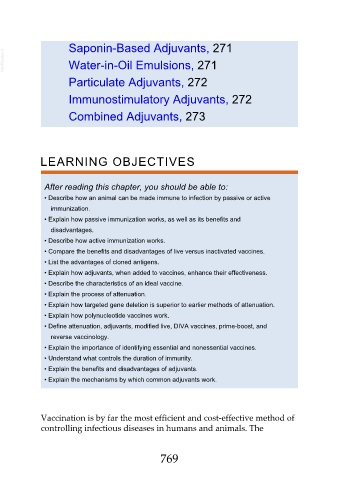Page 769 - Veterinary Immunology, 10th Edition
P. 769
Saponin-Based Adjuvants, 271
VetBooks.ir Water-in-Oil Emulsions, 271
Particulate Adjuvants, 272
Immunostimulatory Adjuvants, 272
Combined Adjuvants, 273
LEARNING OBJECTIVES
After reading this chapter, you should be able to:
• Describe how an animal can be made immune to infection by passive or active
immunization.
• Explain how passive immunization works, as well as its benefits and
disadvantages.
• Describe how active immunization works.
• Compare the benefits and disadvantages of live versus inactivated vaccines.
• List the advantages of cloned antigens.
• Explain how adjuvants, when added to vaccines, enhance their effectiveness.
• Describe the characteristics of an ideal vaccine.
• Explain the process of attenuation.
• Explain how targeted gene deletion is superior to earlier methods of attenuation.
• Explain how polynucleotide vaccines work.
• Define attenuation, adjuvants, modified live, DIVA vaccines, prime-boost, and
reverse vaccinology.
• Explain the importance of identifying essential and nonessential vaccines.
• Understand what controls the duration of immunity.
• Explain the benefits and disadvantages of adjuvants.
• Explain the mechanisms by which common adjuvants work.
Vaccination is by far the most efficient and cost-effective method of
controlling infectious diseases in humans and animals. The
769

